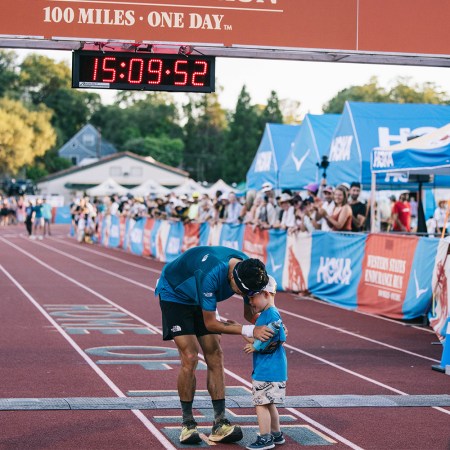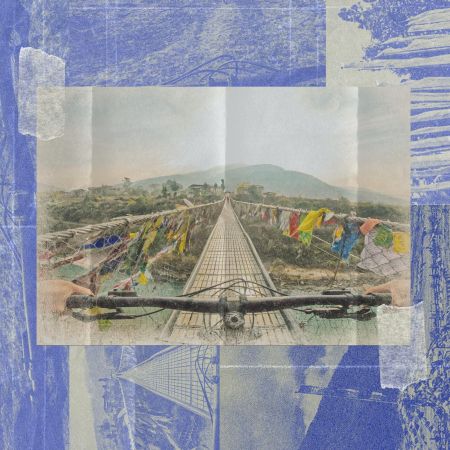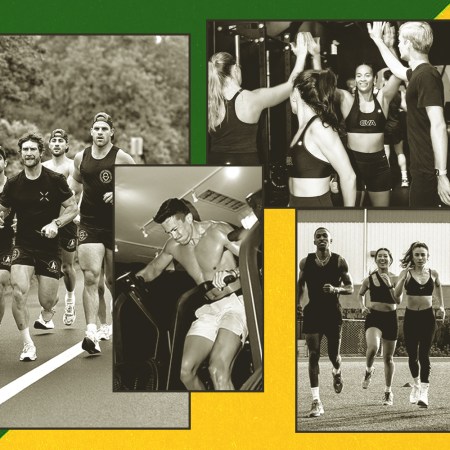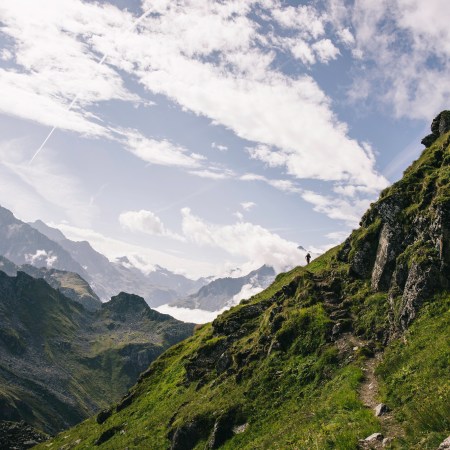Before I spent two hours over two days with Julien, an instructor at the Bürgenstock Resort just outside of Lucerne, Switzerland, I hadn’t taken a tennis lesson since 2011. I was 15 then. I had a man’s appetite but a boy’s soft body. Fifteen or so extra pounds jiggled at my hips and chest. My legs were skinny, and so were my arms.
I was a decently talented player then. I hit a controlled forehand, I had touch and discipline around the net, I rarely double-faulted (and when I did, I screamed fuck with such venom my opponents often froze stock-still). My backhand was unwieldy — I never grasped which arm, right or left, should lead the swing — but in that final lesson I played well enough that as I shyly probed about my future in the sport, the pro told me I could probably walk on to a DIII college team.
I quit tennis a couple years later, more or less on the eve of my high school’s varsity tryouts. I had only recently entered puberty, and my necessary parts — the wrists to flick for topspin, the knees to bend for even basic movement — felt stretched and delicate. My legs were longer but my torso hadn’t grown in step; I might’ve found better balance on stilts. More than a dose of physical grace, I would have benefited from some inner resolve if I hoped to beat out my evenly-proportioned competitors, who were also vying to move up from JV and earn a spot on the doubles roster.
But the death of my dad a few years earlier had caved me in and hollowed me out. Even at the end of his struggle with a neurological disease, my dad, a former publisher of Tennis Magazine, slurred advice and encouragement from his wheelchair. Without him, I was alone with my fickle backhand, creaky bones and Andrey Rublev-level self-laceration.
The Diamond Domes
When I meet Julien at The Diamond Domes — Bürgenstock’s indoor, rust-colored, carpeted courts — he knows none of this. He knows only what I tell him about myself: that I played as a kid and teenager and am now lucky to get on a court in New York once a week for an hour of singles. As we warm up with mini-tennis, Julien tells me about his background.
He started playing at age four or five. By eight he was homeschooled to optimize a training regimen. He laughs politely when I ask if it was aptitude or passion that hastened his commitment to the sport — he says he was a natural from the start. At 17, he left his native France to play college tennis for the University of Nevada-Reno, before transferring to the University of South Alabama, where he faced Ben Shelton in doubles in the first round of the 2021 Division I Men’s Championship (“He was very confident,” Julien said neutrally when I asked a leading question about his impression of Shelton). After graduating from South Alabama, he went back to Nevada, where he filled out his 6’5” frame under the watch of Gil Reyes, Andre Agassi’s legendary trainer. He then played a bit in ITF Futures tournaments overseas, until his $150 winnings from a first-round loss at the M15 Sofia in Bulgaria, deposited against the four figures he’d spent on travel and lodging, clarified the untenability of his career.
Coming from New York, where guys who did walk on to DIII teams charge $125 per hour for their advice and example, I am heartened by Julien’s résumé. I should probably also be heartened by his patient, self-contained demeanor — should take his lead and ease into our baseline training with methodical, slowed groundstrokes — but within five minutes of drilling crosscourt backhands and up-the-line forehands, I’m so gassed that Julien has to call for a water break.
He tells me to relax. It’s rarely relaxing to be told you need to relax, but in this case he is right. The unspoken problem is I’m trying to impress him; the teachable problem is footwork. As I alternate between forehands and backhands, I should be drawing a V with my movements, shuffling nimbly into my strokes from a point a few feet behind the center mark. Instead I’m straining horizontally from ball to ball, slapping back his returns with outstretched form and gasping breath. He wants me to take my time setting up my shots, and to take a few more short bouncy steps before turning my hips away from the net, lowering my shoulder, planting my feet, and following through to a natural equilibrium, all while keeping my head still and watching the ball meet the strings of my swinging racquet.
This process is extremely basic — it outlines the fundamentals of hitting — but it is also impossible to execute while lingering on perhaps the most staggering fact of Julien’s biography, which is that he took a service game off Jannik Sinner in a practice set at the 2023 French Open, where he was a hitting partner to a roster of stars that also included Holger Rune, Jack Draper and Lorenzo Musetti. With this fact in mind I become increasingly seduced by a ridiculous notion: if I can prove myself to hit with close to as much pace and precision as a two-time Grand Slam winner, Julien might feel compelled to advise me to resign from my day job in literary scouting and commit to training for a Futures tournament. The fantasy continues with each heaving stroke: maybe at one such tournament I’ll meet a similarly scrappy late bloomer and form an unlikely doubles duo that qualifies for, let’s say, the 2031 U.S. Open, and flames out with dignity in the quarterfinal.

Overlooking Lake Lucerne
At our next break, Julien kindly asks how I’m finding the Bürgenstock. I’d rather discuss honing my dark-horse potential (could he arrange an introduction to Gil Reyes?) but I relent and admit I’m finding the Bürgenstock really awesome. Who wouldn’t. The Bürgenstock is a 151-year-old, five-star hotel built into a limestone mountain ridge of the same name. It has an enormous spa with an infinity pool and serves waffles with fresh honeycomb at breakfast and is set roughly 1,600 feet above Lake Lucerne, between Mount Pilatus to the west (elevation: 6,983 feet) and Mount Rigi (5,896 feet) to the north, whose rocky peaks appear perpetually encircled by a crown of clouds.
During my stay, clouds blanket lower terrain as well, but their soft light enhances the glossy lake and emerald valleys. When the clouds eventually scatter, the sky arcs high, and when the sun sets, bursts of pink and orange soften the angular horizon. A steady clang of cowbells from nearby family farms makes this grand pastoral beauty feel specific.
If Julien had asked how I found Bürgenstock’s architecture, I would have said: eclectic. The main hotel, The Contemporary, is a sturdy, glassy rectangle that prizes wide vistas over the lake and mountains. Its piazza leads to The Heritage, a Belle Époque palace with narrow windows and tight balconies and an arched facade. Down the road stands an unpretentious 12-room chalet, Taverne 1879, which defiantly radiates a Swiss homeliness absent from its greater luxe environment. At the Bürgenstock, idiosyncrasy reigns — rationalizing structures like a flat-roofed, Frank Lloyd Wright-inspired villa-cum-Persian-restaurant; a provincial white chapel, which hosted longtime guests Audrey Hepburn and Mel Ferrer’s 1954 wedding ceremony; and the Waldhotel, an eco-hotel opened in 2017, displaying rocks salvaged from its construction in wired bundles along its side wall.
I’m desperate to get this right — not for self-improvement, but to expedite the theater of receiving instruction.
As Julien and I return to our baseline business, I would like to but can’t summon a tingly, embodied gratitude for my surroundings. I’m too busy muttering cruel things to myself about my forehand. I usually consider it a strength, but today it’s sailing long, clipping into the net, tailing out wide; it’s not flowing, which I’m inclined to attribute to stage fright or fatigue. Julien, however, finds structural faults: I coil my arm too much in my backswing, which pressures my wrist into generating the stroke’s power and jams up any possibility of a complete follow-through. What if, he warmly suggests, I adjust my footwork and positioning to strike the ball farther from my body, providing more arm-driven sweep to my form?
I blink and Julien is crouched a few feet away, softly tossing me practice balls. I can feel my cheeks blooming red as he cheers and modifies my effort to overhaul two decades of muscle memory. I’m desperate to get this right — not for self-improvement, but to expedite the theater of receiving instruction, of graciously acknowledging my flaws and pretending I’m someone who can instantly convert a professional’s teaching into lasting change.
Julien goes back to his side of the net and I try to integrate all his guidance — the movement stuff, the forehand innovation, a tighter stance on my backhand — as we play out the lesson’s final minutes. Sometimes I do it right. I turn my hips and shoulders swiftly, I keep my eye on the ball and follow through, I submit to the churn of long rallies with patient shots hit deep into the court. I inevitably mess up, too. Sloppy footwork, old forehand habits. I think of the modest measures I took in the preceding weeks to prepare for my time inside The Diamond Domes. There was a lot of core and leg work at the gym. Peloton monotony. I tracked my protein intake and ate bananas because potassium prevents cramping. It was exciting to practice even an elementary fitness program in anticipation of court time with a world-class tennis player, but now it feels embarrassing to have thought it might make a difference.
When we wrap up I say some maudlin shit about how I usually end tennis sessions having renewed the belief that I’m a good player. Shoulder shrug, weak laugh, eyes fixed on the floor: but today I don’t feel that way. Julien won’t humor my self-pity. “There’s levels of good,” he says evenly.

Recovery’s for Athletes
At Bürgenstock’s 107,000-square-foot Alpine Spa, where I’ve gone to decompress after my lesson, I waver between two DIY wellness journeys: “Recover,” a post-workout program that requires cold plunging, and “Relax,” a civilian option that involves floating in a saltwater pool. Recover, I decide, is for athletes, which, after my Diamond Domes disaster, I can no longer — if I ever could reasonably — claim to be. So I float in the saltwater pool and brood for an hour, like a Sofia Coppola cliché.
Dinner that night is at Spices Kitchen, where the food shocks me out of ennui. I was skeptical of the restaurant’s mission to cohere the cuisines of Japan, China, India and Thailand, but Spices earns its 16 Gault & Millau points, awarded to restaurants with “an established artistic expression serving personalized dishes with remarkable execution.” The maguro tataki’s pink center soaks up enough of its tart ponzu dressing to sharpen the experience of moist, tender tuna. The xia jiao seems banal until you pop one in your mouth and relish the ordinary delight of plump and juicy prawn dumplings. Everything is good but nothing is as good as Spices’ take on larb ped, which trades the traditional minced duck meat for crunchy slices slicked with a piquant lime sauce.
They Call It Tennis Paradise
Sunny, disorderly, sublime: our racquet correspondent charts one unforgettable weekend at Indian Wells, the sport’s desert meccaSleep comes easy to the satisfied. The next morning I walk through gray mist to my final lesson with Julien. There will be no more groundstroke humiliation. We start with my backhand slice. He’s generally impressed with my high-low motion but observes I wave my right arm — the one holding the racquet — unmethodically and too extremely through the stroke, which varies spin and placement from point to point. With Julien’s help I find improving the shot is almost as simple as shortening and softening the swing. It also requires slightly closing my racquet head at contact, which keeps the ball gliding low over the net. In subsequent rallies I’m able to maintain this correct form. That I have so fluently adapted my game to Julien’s coaching makes me feel effective and, in triumphing over disordered defeatist self-talk, brave. An invigorating symbiosis develops between us. Julien spots a weakness in my net play — I struggle with half-volleys — and prescribes a solution I absorb like a child learning language: keep your feet moving through contact and let your body’s forward momentum carry the return.
We shift to serving. My first of the day is a fastball down the T. I have never hit a serve so cleanly in my life. I try to swallow a smile as I walk back to the basket, but Julien’s eyes, widened with an underestimator’s surprise, meet mine, and we both start to laugh. “I got it like that,” I joke, and as I blitz through a few more first serves — deuce side at the body, ad side out wide — I do kinda got it like that. The exhibition reverts to a lesson when I demonstrate my second serve, which is cut with slice and retains 80% of my first serve’s pace, and Julien tells me my second is faster than his. I go: “Hell yeah.” He’s like: “That’s not a good thing.” I should hit a kick serve. Kick serves are slower but clear the net with great height and spin wildly; they challenge a returner’s timing and bounce outside of a comfortable strike zone. To hit a kick serve I need to adjust my ball toss, so that it drifts straight above my head. There are other important considerations — something about the extension of my arm and rotation of my wrist at contact — but I’m able to intuit the serve’s mechanics without a prolonged intervention.

Levels of Good
Where this pliability was yesterday is a question Julien will never consider and one that will always haunt me. To think of the strides I could have made with my groundstrokes — I drop those punishing thoughts when Julien extends his hand for a shake. Our hour is up. I thank him for everything. I feel the tingly gratitude that confirms I am fully present, aware of my fortune in sharing a court with a player of his caliber in a setting as picturesque as The Diamond Domes. When that feeling fades I suppress the urge to ask if he thinks I could have made the team at Bowdoin or Hamilton had I grown sooner and had my dad not died.
It’s only 11 a.m. when we say goodbye. I eat a banana; I’m loose and buzzy; I got some energy to expel. Everyone’s been talking about how I have to check out the Hammetschwand Lift, the highest exterior elevator in Europe. I’m moderately acrophobic but I’m in Switzerland. The lift rattles for a daylong minute as it carries me 500 feet up from a cliffside path to the crest of the Bürgenstock ridge. I clutch too-low side railings and wobble across a wood-planked walkway that connects the elevator’s exit — perched atop a metal tower rising through open air — to solid earth. The view is good but not the panorama I’ve been promised; a café blocks a western lookout, and a thicket of brush blocks my northerly interest.
I approach a group of French hikers and in barbaric American fashion dumb down my English to ask: “Better view somewhere?” They scoff and point me toward a winding dirt path that leads to a clearing 30 or so feet higher. Here everything is available: new pearly pockets of Lake Lucerne, new snow-capped peaks of the Alps, more cloud-shadowed treescapes. I remember the wisdom and bite of Julien’s line about there being levels of good tennis. From the highest and best view of the world that Bürgenstock offers, I don’t see any problem being somewhere in the middle.
Whether you’re looking to get into shape, or just get out of a funk, The Charge has got you covered. Sign up for our new wellness newsletter today.


























